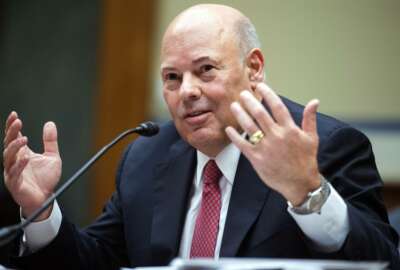

Low-risk investments generally have low returns. By law, the Postal Service must invest retiree assets in U.S. Treasury securities. The Office of Inspector Gene...
Low-risk investments generally have low returns. By law, the Postal Service must invest retiree assets in U.S. Treasury securities. The Office of Inspector General took a look at how much USPS would have had now, with a stock-and-bond mix. Wow. For more, Federal Drive with Tom Temin spoke with Research Specialist Joy Sanzone.
Interview Transcript:
Tom Temin And you looked at this, I guess, academically, because by statute, if that’s how they have to invest their retirement funds, that’s how they have to invest them. So what caused you to take a look here at what they would have had by now if they had a 60-40% stock bond mix?
Joy Sanzone Sure. So this work builds on prior OIG work that has done similar work looking into retiree assets. Several years ago, the OIG did a paper that looked forward, whereas the paper we’re talking about today was a historical look. We looked forward at the potential impact of investing funds today and what the impact would be in 20 years. And the impact of a similar bottom line to this paper is that the impact would be significant for the Postal Service with even a modest amount of diversification. This was also a board request to look into this, and we were interested to just see what would the Postal Service have had today had they invested as much as 50 years ago and compare that to their actual investment strategy.
Tom Temin All right. So at the end of fiscal 2022, they had $298 billion in to pay out retirees. And before we get to what they would have had, is that enough to cover their future liabilities?
Joy Sanzone No. So their current balance is $298 billion, but their current liability for future retiree benefits is $394 billion. So almost a $100 billion unfunded liability.
Yeah. And so I guess their name is Legion in that respect. We have this kind of a time bomb across the government, across the country, really. And so if they had invested, at what point in time did you calculate from and what would they have had today with a more diversified portfolio?
Joy Sanzone Sure. So we looked back as much as 50 years. So we looked at CSRS, FERS and the Postal Service Retiree Health Benefits Fund, which are the three retirement programs the Postal Service participates in. For CSRS we look back to 1972, which is when the Post Office department became the Postal Service. For FERS, we look back to 1988, which was the year the fund started, and for the Health Benefits Fund looked back to 2007, which is the year that fund started. So again, as much as 50 years. And what we found was that across those three retirement programs, the Postal Service could have had $1.2 trillion across those three funds if they had invested in a mix of 60% stocks and 40% bonds.
Tom Temin So they would have had three times their liabilities at this point. And that money could then be available to, I don’t know, sit there or hire more postal people or what could they do with that money if they had that much of a surplus?
Joy Sanzone Yeah, there’s a lot of potential financial implications for the Postal Service. As you said, investing in its workforce is a potential use of that money. They could also invest in their processing and delivery network. There’s also potential it could in the future minimize price increases. So the Postal Service must cover its costs through revenue. And obviously retirement expenses are a significant cost. So minimizing those expenses going forward could help minimize price increases as well.
Tom Temin Right. And doing this exercise, though, is like pretending you won the lottery, imagining what you would do if you had all that money. It’s kind of academic because there’s no gambit that I’m aware of in Congress to allow them to invest any differently than they have now. Right.
Joy Sanzone Correct. It’s come up a couple of times, but it has not been included in any of the postal reform legislation.
But is that the purpose of the research to kind of tell Congress, well, if you wanted to change it, here’s what is likely to happen.
Right. So the goal of this paper was really to be informative. We didn’t give any recommendations to the Postal Service, but we wanted this to be informative for the Postal Service for Congress and any other postal stakeholders. As you said earlier, the opportunity lost and what the potential is going forward for investing retiree assets.
Tom Temin We’re speaking with Joy Sanzone. She’s a research specialist with the Postal Service Office of Inspector General. And I’m looking at the chart at some of the other investment funds that you mentioned or funds that you mentioned, the FERS and also the the CSRS of which there are still a few beneficiaries around. They’ll be around for, we hope, quite a number of years. And they also have pretty bad deficits with respect to their future payouts.
Joy Sanzone So, yes, so for CSRS, the deficit currently is about 41 billion. For FERS, it’s about 32 billion and for the health benefits fund, about 24 billion in deficit. So total across the three is a deficit of about $96 billion.
Tom Temin Right. And that gets back to that liability that the Postal Service has versus what it has on hand. So what do postal planners say about this? I mean, they must. I mean, this is the sustainability of finances that the Postal Service has been a subject of some discussion now for probably 20 years. And there was a little bit of reform last year. But as the postmaster general says, they’re still not out of the woods because the network is changing, the revenue sources are changing, Everything else is changing also. So how could postal planners use this information to change things, do you think?
Joy Sanzone Yeah, well, again, this was meant to be an informative paper about what is the potential of investing. And it goes along with prior OIG work that look to the future and projected what they could have had if they had invested. The Postal Service would need to request congressional action would be required since this current investment strategy is dictated by law. So Congress would need to take action to allow the Postal Service to invest any differently.
Tom Temin And looking at this from the standpoint of an individual postal employee defers retirement, that they’ll have the ones currently working or some of the old timers maybe, on retirement in their SERS program. The other component, well, let’s talk about FERS. The other component is Social Security, which they would have and of course, TSP. So really for the average person, your findings reinforce the fact that the average investor employee needs to plow as much as they can, as aggressively as they feel comfortable into their TSP to compensate for the anemic postal general pension funds.
Joy Sanzone Yeah, I think that’s a great observation. Our paper doesn’t get into the implications of in the future of currently these funds have an unfunded liability, but we don’t get into anything about the benefits for individual employees. That’s really outside the scope. But that’s a that’s a great observation about the TSP.
Tom Temin And you’re an individual postal employee. What is your strategy for? I mean, you’re still pretty young judging from the picture I’m seeing on Zoom, but someday you’ll retire. What’s how do you approach it?
Joy Sanzone I’m not really sure how to answer that question.
Tom Temin But you have a TSP account, I presume?
Joy Sanzone I do.
Tom Temin And so that’s where you you play around and see what you can get to maximize investments. Fair.
Joy Sanzone Yeah. That’s my personal goal. Yes.
Tom Temin All right. Well, I think you again, your name is Legion here. And have you had any reaction to this study, to this paper saying, hey, look, guys, if this were the case, that would be the outcome. Again, academic. But any response yet?
Joy Sanzone Yeah. So this has actually come up with the board of governors at their recent meeting. And actually, in fact, it came up at the postmaster generals testimony last week, which I think really underscores the importance of this issue. PMG DeJoy was asked a question about this, observing that there’s currently 290 billion in the fund where they could have had the 1.2 trillion, and the PMG really underscored that this would be incredibly significant for the Postal Service for it to happen. So I think that it came up then really underscores how big this might be.
Copyright © 2024 Federal News Network. All rights reserved. This website is not intended for users located within the European Economic Area.
Tom Temin is host of the Federal Drive and has been providing insight on federal technology and management issues for more than 30 years.
Follow @tteminWFED


